
The New Century Club of Philadelphia, Pennsylvania was founded in 1877. It was one of the first women's clubs in the United States, and included professional women as well as women active in women's rights and the abolition movement.

The New Century Club of Philadelphia, Pennsylvania was founded in 1877. It was one of the first women's clubs in the United States, and included professional women as well as women active in women's rights and the abolition movement.
In 1876 the Centennial Exposition was held in Philadelphia and had a Women's Pavilion, which was the springboard for the creation of the New Century Club in January 1877. [1] In 1879 it was incorporated, one of the nine incorporators was Emily Sartain. [2]
One of the first women's clubs in the United States, [3] its purpose was to provide a meeting place for its members and to promote "science, literature and art." [4] The club, described as a "centre of thought and action among women" in its constitution, initially offered programs to help educate and aid working women and to address municipal concerns, and later into social reform. [2] It focused on issues affected women and children – like child labor laws, education, and legal defense – and other civic and cultural issues. [3] Committees in 1894 included Club Organization, Education, Study, Library, Reception, Entertainment, Working Woman's Guild, Public Interests, Legal Protection of Working Women, and the Browning Society. [4] Although the club avoided public controversy by downplaying involvement in "radical" causes such as the suffrage movement, its members were active in a wide range of reforms. [2]
The New Century Club was declared in Philadelphia's Cultural Landscape: The Sartain Family Legacy (2000) to be "an influential early manifestation of the woman's club movement that swept through the country at the turn of the century. This movement brought thousands into associations where they met other ambitious, energetic women, developed organizational and leadership skills, and articulated a belief in social welfare and urban improvement that anticipated much Progressive Era social reform." [2] It served as a support for professional women until individual, profession based organizations for women, such as The Plastic Club for artists and the Women's Homeopathic Medical Club, were founded starting in the 1890s. [5]
The club founders included professional women and women who had been active in women's rights and the abolition movement. [2] One of the founders was Sarah Catherine Fraley Hallowell, a journalist with the Philadelphia Ledger, was the club's first president. Other founding members were Elizabeth Croasdale and Emily Sartain, who were pass and contemporary school principals at the Philadelphia School of Design for Women; writer Eliza Sproat Turner; [2] veteran campaigner Mary Grew [6] and physician and later dean of Woman's Medical College of Pennsylvania, Clara Marshall. Turner became the club's third president. [2] Initially there were 40 members and by 1879 there were 120 members and the club was located on Girard Street in Philadelphia. [4]
In 1882, Eliza Sproat Turner and other members formed a committee for working women named the New Century Guild. Its purpose was to provide education and opportunities for working women to learn a vocation. Soon after the Guild became a separate organization and it needed its own building by 1892 to support programs and classes. The New Century Trust was formed in 1893 to facilitate funding for its first building. [1]
The club moved to a larger place at 1520 Chestnut Street in the Baker Building for the 400 member organization and began plans for an even larger place at 124 Twelfth Street. Architect Minerva Parker Nichols designed a club house of Italian Renaissance architecture, of Indiana limestone and Pompeiian brick at and estimated cost of $80,000. The building had parlors, committee rooms, a library, and a six hundred person capacity drawing room. Gabrielle D. Clements created murals symbolizing Charity, Labor, Science and Art. The effort was led by the club's president, Mrs. Henry C. Townsend. [4]
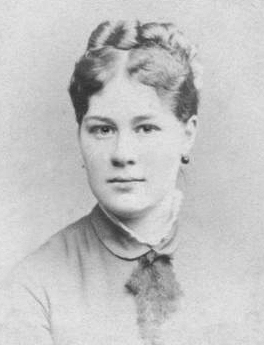
Eliza Cecilia Beaux was an American artist and the first woman to teach art at the Pennsylvania Academy of the Fine Arts. Known for her elegant and sensitive portraits of friends, relatives, and Gilded Age patrons, Beaux painted many famous subjects including First Lady Edith Roosevelt, Admiral Sir David Beatty and Georges Clemenceau.

Turners are members of German-American gymnastic clubs called Turnvereine. They promoted German culture, physical culture, and liberal politics. Turners, especially Francis Lieber (1798–1872), were the leading sponsors of gymnastics as an American sport and the field of academic study.
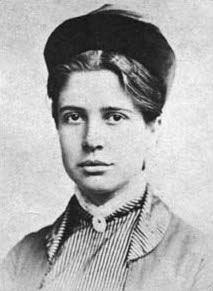
Florence Moltrop Kelley was an American social and political reformer who coined the term wage abolitionism. Her work against sweatshops and for the minimum wage, eight-hour workdays, and children's rights is widely regarded today.
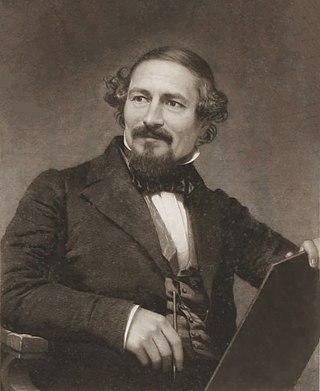
John Sartain was an English-born American artist who pioneered mezzotint engraving in the United States.

The Philadelphia Ten, also known as The Ten, was a group of American female artists who exhibited together from 1917 to 1945. The group, eventually numbering 30 painters and sculptors, exhibited annually in Philadelphia and later had traveling exhibitions at museums throughout the East Coast and the Midwest.
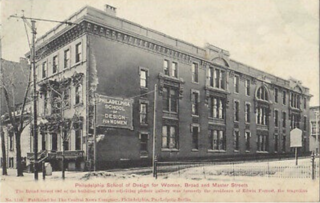
Philadelphia School of Design for Women (1848–1932) was an art school for women in Philadelphia, Pennsylvania. Housed in the former Edwin Forrest House at 1346 North Broad Street, under the directorship of Emily Sartain (1886–1920), it became the largest art school for women in the United States. Its faculty included Robert Henri, Samuel Murray and Daniel Garber. In 1932, it merged into what is now the Moore College of Art and Design.
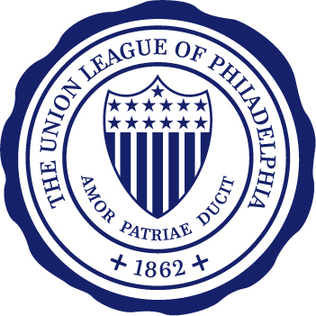
The Union League of Philadelphia is a private club founded in 1862 by the Old Philadelphians as a patriotic society to support the policies of Abraham Lincoln. As of 2022, the club has over 4,000 members. Its main building was built in 1865 and added to the National Register of Historic Places in 1979.

The New Century Guild, now the New Century Trust, is an historic women's support organization which is headquartered in Philadelphia, Pennsylvania. Founded in 1882, it is one of the oldest and largest organizations devoted to meeting the needs of women in the labor force.

Moore College of Art & Design is a private art school in Philadelphia, Pennsylvania. It was founded in 1848 by Sarah Worthington Peter as the Philadelphia School of Design for Women, and was renamed the Moore College of Art & Design in 1989. Although the school's undergraduate programs were historically only open to women, Moore opened admission to transgender, nonbinary, and gender-nonconforming students in 2020. Its other educational programs, including graduate programs and youth programs, are co-educational.

Frederick Graff was an American hydraulic engineer who designed and built the Fairmount Water Works in Philadelphia, Pennsylvania, and unofficially invented the fire hydrant.
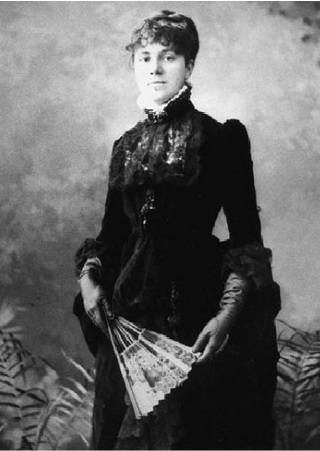
Emily Sartain was an American painter and engraver. She was the first woman in Europe and the United States to practice the art of mezzotint engraving, and the only woman to win a gold medal at the 1876 World Fair in Philadelphia. Sartain became a nationally recognized art educator and was the director of the Philadelphia School of Design for Women from 1866 to 1920. Her father, John Sartain, and three of her brothers, William, Henry and Samuel were artists. Before she entered the Pennsylvania Academy of the Fine Arts and studied abroad, her father took her on a Grand Tour of Europe. She helped found the New Century Club for working and professional women, and the professional women's art clubs, The Plastic Club and The Three Arts Club.

Florence Esté was an American painter in oils born in Cincinnati, Ohio. She also worked in watercolors, pastels, and as an etcher and engraver. She was particularly well known for her landscapes, which were said to have been influenced by Japanese artworks and were noted for their "harmony of color". Her obituary in the New York Times referred to her as "one of the best known women landscape painters."

The Plastic Club is an arts organization located in Philadelphia, Pennsylvania. Founded in 1897 for women only, the Plastic Club is one of the oldest art clubs in the United States. It is located on the 200 block of Camac Street, the "Little Street of Clubs" that was a cultural destination in the early 1900s. Since 1991, the club's membership also includes men.

Sarah Catherine Fraley Hallowell or Sarah Cresson Fraley Hallowell (1833–1914) was an American journalist. She was editor of The New Century for Women, editor of the Public Ledger in Philadelphia and founder and first president of the New Century Club.

Gabrielle de Veaux Clements was an American painter, print maker, and muralist. She studied art at the Philadelphia School of Design for Women, Pennsylvania Academy of the Fine Arts, and in Paris at Académie Julian. Clements also studied science at Cornell University and graduated with a Bachelor of Science degree. She created murals, painted portraits, and made etchings. Clements taught in Philadelphia and in Baltimore at Bryn Mawr School. Her works have been exhibited in the United States and at the Paris Salon. Clements works are in several public collections. Her life companion was fellow artist Ellen Day Hale.

Eliza L. Sproat Turner was an American writer, women's club founder and leader, abolitionist, and suffragette. Turner began her adulthood as a teacher and writer, and soon after became involved in a number of social causes. She was a member of the Philadelphia Female Anti-Slavery Society and was a leader of the Women's Congress and the publication of the New Century for Women newspaper for the Philadelphia Centennial Exposition of 1876. The following year she helped found the New Century Club women's club and in 1882 was instrumental in the establishment of the New Century Guild of Working Women. Her poetry and viewpoints about women's issues were published in newspapers and magazines.

The Pennsylvania School of Horticulture for Women was one of the first horticultural schools to be established by and for women in the United States, opening on February 10, 1911. As the second institution to provide women with a practical education in horticulture and landscape architecture, it made possible their entry into a professional field. Although some men were employed in faculty positions, the school's leadership was intentionally female. As of 1919, the board of trustees consisted of twenty-five prominent women citizens. All but the last director of the school were women.
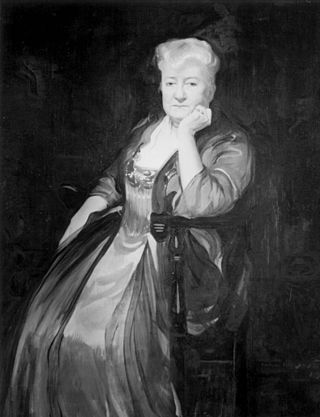
Sara Yorke Stevenson was an American archaeologist specializing in Egyptology, one of the founders of the University of Pennsylvania Museum of Archaeology and Anthropology, suffragist and women's rights activist, and a columnist for the Philadelphia Public Ledger.
Harriet Sartain was an American artist, arts educator and college administrator. She was dean of the Philadelphia School of Design for Women, which became part of the Moore College of Art and Design in 1932.